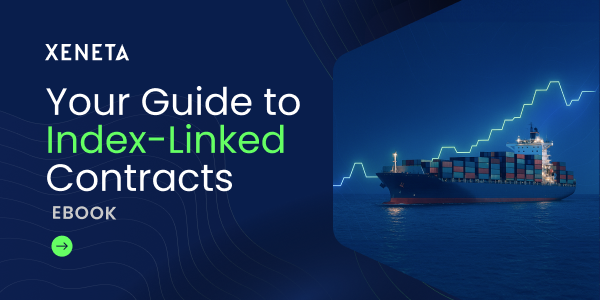Ocean Freight Calculator: Calculate Shipping & Freight Costs
Unlock the true long-term market average for Ocean Freight (40' Dry) on your key trade lanes
Instantly calculate your freight costs
What impacts your shipping rates?
Freight rates are highly sensitive and fluctuate due to a variety of factors.
Distance
Container Size
Market Demand
Geopolitical Events
Ocean Freight Analytics
Explore Our Ocean Freight Solutions
Visualize your rate and volume data in one place
Ocean Analytics takes you one step further into shipping success: after you’ve monitored the state of the market, it's time to understand your place in it and analyze where there’s room for improvement.
With a data-driven view of the factors that impact your supply chain, such as performance by supplier and spend comparison per corridor, your opportunity to improve will never be clearer.
Instant Insight, Smarter Ocean Procurement
- Access to 500+ million ocean freight rates for over 170,000 port-port pairs
- Freight rate market intelligence for 20' & 40' standard dry, 20' & 40' reefer and 40' HC containers
- Full comparison of your freight rates to the actual short-term and contract market rates
- Data export functionality to enable your own offline rate analyses
- Surcharge data for congestion, fuel, and peak season surcharges—the full picture of your overall shipping price
- All our products and services adhere to ISO 27001:2022, ensuring the highest standards in Information Security.
Ocean Freight Calculator FAQs
How does the calculator work?
Xeneta's Freight Rate Calculator leverages our database of over 500 million real-time ocean and air freight rates to provide accurate, up-to-date cost estimates.
Input your corridor, approximate cost per container and industry and we’ll give you an market rate based on current benchmarks.
The calculator utilizes Xeneta's proprietary data aggregation and benchmarking methodologies to deliver precise insights tailored to your specific trade lanes.
How do you calculate shipping rates?
Freight rates are influenced by a range of variables, including distance, cargo type, container size, weight or volume, surcharges and current market conditions. A common formula for calculating freight cost is:
(Base Rate + Fuel Surcharge + Other Surcharges) × (Weight or Volume) + Additional Services
Here’s a breakdown of key cost components:
Base Freight Charges: The core cost of transporting goods between ports.
Surcharges: Additional fees such as fuel surcharges, security fees, and currency adjustments.
Terminal Handling Charges (THC): Fees for loading and unloading containers at ports. Xeneta incorporates these in its rate calculations using a proprietary THC methodology tailored to origin and destination ports.
Market Dynamics: Factors like demand, capacity constraints, and geopolitical events that cause rate fluctuations.
With such a range of variables, freight pricing is highly sensitive and constantly changing. Xeneta analyzes over 500 million rates across 230,000+ trade lanes, providing you with the real-time market intelligence needed to mark smarter, data-driven decisions in freight procurement.
Why has shipping freight become so expensive?
Freight is a highly volatile market as global supply chains are more interconnected and therefore more fragile than ever before. Shifts in trade policies, demand, geopolitical events can all have significant ripple effects.
Several factors contribute to the rising costs of shipping:
Increased Demand: A surge in global trade has led to higher demand for shipping services.
Capacity Constraints: Limited availability of shipping vessels and port congestion have reduced capacity.
Fuel Prices: Fluctuations in fuel costs directly impact shipping expenses.
Geopolitical Events: Trade disruptions, policy and regulatory changes can affect shipping costs.
Xeneta's platform provides insights into these factors by offering real-time rate data and market trends, helping users understand and navigate the complexities of the shipping industry.
When can I access live freight rates?
You can access live international freight rates and trends via the Xeneta Shipping Index (XSI-C), which provides real-time, market-driven insights.
Updated regularly with data from over 500 million rates across 230,000+ trade lanes, the XSI-C offers you up to date freight insight.
Explore the XSI-C here: Xeneta Shipping Index.
The XSI-C delivers market-level data, offering broad insights into global shipping trends, which is great for understanding general freight movements.
However, for detailed, lane-specific benchmarking, the Xeneta platform gives you the ability to explore specific rates for your origin and destination, empowering you to make data-driven decisions on your shipments.
For more granular data with tailored insights into your specific trade lanes, explore the Xeneta platform.
Do you have a calculator for air freight?
How is Xeneta's data sourced?
Xeneta's data is derived from a comprehensive and neutral aggregation of freight rates sourced from a broad user base, including shippers and freight forwarders.
This data encompasses both short-term and long-term rate contracts, with updates ranging from monthly to multi-year agreements. To ensure reliability, Xeneta requires a minimum of five valid rates per route, per day, per equipment type before releasing any market information. For mature trade routes, this often translates to several hundred valid rates per day, enhancing the accuracy of their benchmarks.
The data is organized using Xeneta’s Geo-Hierarchy, which groups ports based on pricing correlations rather than geographical proximity. This methodology allows for precise port-to-port pricing insights, particularly in regions like North Europe and the Far East. Additionally, Xeneta employs statistical sampling to capture market tendencies, ensuring a broad and representative dataset.
Xeneta anonymizes all collected data, ensuring that no company-specific rates or supplier names are disclosed. This approach adheres to EU/EEA competition laws, promoting transparency without compromising market competition.
For more information read the Xeneta methodology.
%201.png)






